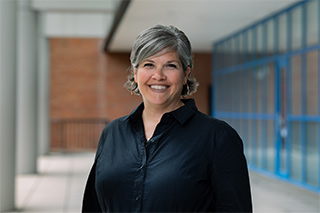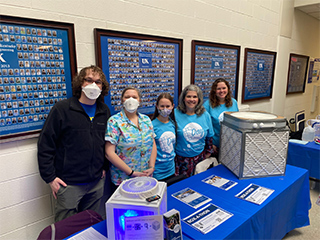
(Photo courtesy of Kelly Pennell)
As a high schooler, Kelly Pennell, Ph.D., learned about a Nigerian environmental and human rights activist named Ken Saro-Wiwa, who railed against the oil industry for inflicting decades of pollution on Ogoni communities of the Niger Delta. The devastation endured by Saro-Wiwa’s people haunted Pennell, and she pledged to one day help others affected by environmental exposures.
“I pursued engineering degrees at Lawrence Technological University, Rose-Hulman Institute of Technology, and Purdue,” Pennell said. “During that time, I realized how truly complex issues of environmental contamination and remediation are.”
During her Ph.D. work at Purdue, Pennell had the opportunity to work at a NASA Specialized Center of Research and Training, where students developed tools to support astronauts during long-term space missions.
“I worked on a closed-loop, water disinfection system and learned so much about multidisciplinary research,” Pennell said.
Pennell now oversees multidisciplinary work in her role as director of the long-running University of Kentucky (UK) Superfund Research Program (SRP) Center, which combines innovations in biomedicine, environmental science and engineering, and data science with expertise in community engagement and research translation to improve public health and promote health. The center currently focuses on ways to alleviate exposures to PFAS and halogenated organic chemicals — including trichloroethylene (TCE) and tetrachloroethene (PCE) — among other toxic substances.
Tracking Chemicals
Within the center, Pennell is also principal investigator of a project examining how chemicals travel from one place to another — a field called fate and transport. One focus is on vapor intrusion, or the movement of gas-forming chemicals into homes and other buildings from contaminated groundwater and soil.
In early work funded by NIEHS, Pennell and colleagues investigated how to improve vapor intrusion assessments. Working with a neighborhood located adjacent to a former chemical handling facility, the team investigated how predictions from a well-established vapor intrusion model compared to field data collected from the area. Their results were intriguing, Pennell recalled.
“Field sampling revealed that sewer gas containing tetrachloroethylene was escaping into indoor air through a faulty seal at the toilet,” she explained. “Prior to this discovery, vapor intrusion models did not account for sewer gas intrusion as an important pathway.”
In fact, sewer gas has plenty of opportunities to move indoors, according to Pennell. In the U.S., over a million miles of sewer pipes exist underground. As aging pipes deteriorate, surrounding contaminants can migrate in and out, spreading to nearby communities. For example, Pennell and team found that a sewer system installed in the 1950s was the culprit behind TCE infiltration at various locations in a San Francisco Bay neighborhood.
Pennell’s team continues to develop ways to measure and predict chemical intrusion from leaking and damaged pipes, with the goal of reducing exposures. In addition to TCE and PCE, they are also examining PFAS.
Combining modeling, PFAS sampling, and extensive publicly available water data, the team developed a diagnostic tool to visualize potential PFAS hot spots in Kentucky. They also published a companion paper to encourage open data sharing among researchers.
“We aim to conduct the best science that is relevant, credible, and moves knowledge forward,” Pennell said. “Science is a process, and if we don’t keep growing, we don’t innovate, and we stagnate,” she said.
Gathering Feedback

(Photo courtesy of UK SRP)
Critical to Pennell’s job is ensuring that her team seeks — and responds to — community concerns. In 2016, for instance, the center hosted an NIEHS-sponsored community forum for people living in Eastern Kentucky, a geographically isolated region that experiences high rates of poverty, low levels of education and health literacy, limited access to grocery stores, and scant opportunities for exercise.
During the two-hour forum — the culmination of a year of planning with community leaders — audience members queried a panel of experts consisting of local health officials, a nutrition expert, and a federal scientist. Twenty participants also answered an anonymous 10-page questionnaire before leaving the forum. In 2018, Pennell and colleagues reported their findings.
“The most common concerns shared during the forum were about chronic diseases and environmental pollutants, particularly in air and water” Pennell said. “The questionnaire also indicated that this Appalachian community is highly aware of environmental hazards and their health risks. On a positive note, the forum indicated that our center is equipped to respond to the complex needs of these communities.”
Building on the forum, Pennell and several colleagues partnered with local community members on an NIEHS-funded community-engaged project to reduce exposures to disinfection byproducts in drinking water in Eastern Kentucky. The team hopes their work can inform strategies to assist other rural communities facing similar drinking water challenges.
Handling Uncertainty
When Pennell became center director in 2020, the COVID-19 pandemic tested her team’s mettle.
“During the height of the crisis, we pivoted,” Pennell said. “It’s one of the accomplishments I’m most proud of.”
With face-to-face community interactions and laboratory research on hold, trainees and faculty sought new projects. For example, Pennell and her collaborators published an article focused on weighing incomplete scientific evidence to inform decisions on the safe reopening of schools.
“These were very heavy lifts, and I will never forget how we made it through and grew during those challenging times. It built resilience and flexibility in us,” Pennell said. “We still had publications coming out, and students staying connected and graduating. And this would not have happened if we did not trust each other and work together.”
Kelly Pennell


